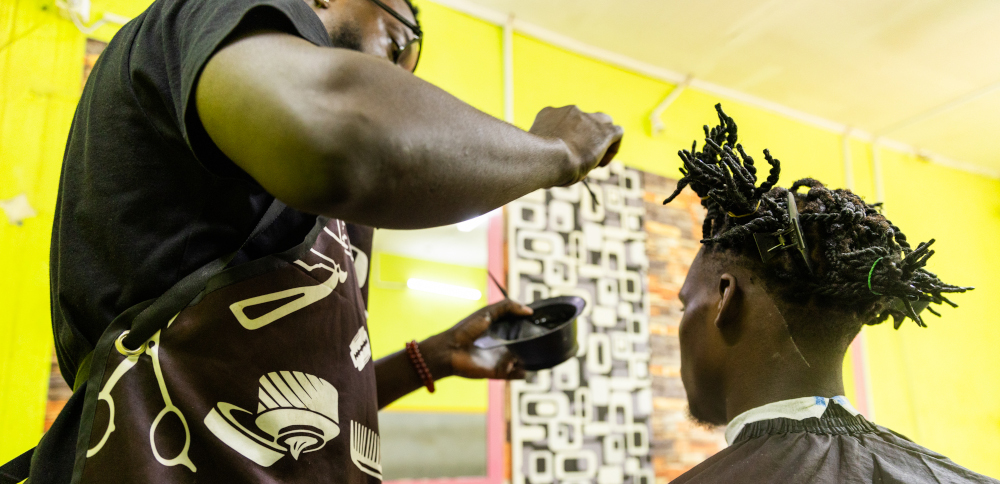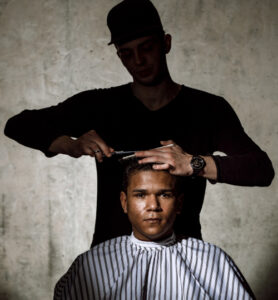
The Quiet Hustle of South Africa’s Street Barbers
There’s a corner in every South African city where the buzz of clippers is as constant as passing taxis and the rustle of plastic bags in the wind. Pavements in Durban, Soweto, East London, they all have their stretch where chairs are lined up, mirrors nailed to corrugated iron, and a generator running like a mechanical heartbeat. These aren’t just barbers. They’re shape-shifters, sculptors, local philosophers. And in 2025, a growing number of them are turning the art of a township haircut into something more than a way to make rent.
Scroll through TikTok or Instagram and it doesn’t take long before you stumble on @FadeGodZulu or @FreshlineEli, street barbers with thousands, sometimes hundreds of thousands, of followers. Their content? Slow-motion videos of razor-sharp hairlines, before-and-after montages, or just candid clips of banter with clients while the next cut takes shape.
It’s a curious kind of fame, hyper-local yet instantly global.
“I didn’t start this to be famous,” says Lwazi Dlamini, a 27-year-old barber from Umlazi who now has over 80,000 followers on TikTok. “At first, it was just me showing my friends. But then one video hit 100,000 views. Now I get guys messaging me from Cape Town, even Jo’burg, asking if I can teach them my fade.” What sets these digital barbers apart isn’t glossy branding or big budgets. Most are still cutting outdoors, dealing with weather, patchy Wi-Fi, and the occasional curious goat wandering into the shot.
Their tools are simple, a ring light clipped onto a car battery, a smartphone propped against a speaker, and the steady patience that comes from years of honing both skill and reputation.
At a glance, it might seem like just another social media trend, but scratch a little deeper and there’s something else happening. For many young South Africans, especially in economically strained areas, traditional employment is thin on the ground. Becoming a street barber has long been a kind of fallback hustle, reliable, practical, low barrier to entry. But now it’s being redefined as a legitimate creative career. The proof is in the bookings.
“You wouldn’t believe how many people find me from Instagram now,” says Ncebakazi, one of the few female barbers carving her lane in KwaMashu. “Guys don’t care if I’m cutting in a shack or a fancy salon, they saw my reel, they like my work, they’ll make the trip.” Beyond the financial boost, there’s cultural weight to what’s unfolding. South Africa has always had a rich grooming tradition, from the traditional head shavings of initiation ceremonies to the sharply defined township looks that have become iconic on the streets.
Now, those styles are being shared beyond the community that birthed them. A man getting a signature Zulu line-up in a dusty alley could end up on a phone screen in New York or London the next day. It’s not lost on the barbers themselves either.
“I used to watch American videos to learn new tricks,” says Lwazi. “Now I see American guys using our styles. That’s power.”
 Of course, it’s not all filters and likes. There’s a rawness that digital fame doesn’t smooth over. Generators fail. Phones get stolen. Load shedding knocks out the lights just as you’re mid-cut. And there’s still scepticism from some older community members who view TikTok as a distraction from ‘real’ work. But it’s clear that for this new generation, the hustle is about more than survival. It’s about visibility, being seen, being known, and rewriting the script on what township success looks like.
Of course, it’s not all filters and likes. There’s a rawness that digital fame doesn’t smooth over. Generators fail. Phones get stolen. Load shedding knocks out the lights just as you’re mid-cut. And there’s still scepticism from some older community members who view TikTok as a distraction from ‘real’ work. But it’s clear that for this new generation, the hustle is about more than survival. It’s about visibility, being seen, being known, and rewriting the script on what township success looks like.
For Lwazi, that means balancing real-world cuts with his digital presence. “I post two videos a day. One in the morning to catch the Jo’burg crowd, one at night for overseas. But in between, I’m here. Same corner, same chair.” Even with the digital shift, there’s something deeply local and grounded about it all. Barbers still shout greetings to passing aunties. Children still come to watch, wide-eyed as hair falls in clean, practiced strokes. The smell of paraffin and braaied meat still drifts past in the background.
It’s this combination, old rhythms meeting new tools, that makes the rise of South Africa’s digital barbers so compelling. There’s no disconnect here between the physical and virtual. The street remains the stage. The camera just widens the lens. You could call it a small thing, an everyday hustle turned Instagram reel. But for the people holding the clippers, it’s more than that. It’s legacy. It’s style. It’s proof that even with nothing more than a chair, a mirror, and a cracked phone, you can make something lasting.
And that’s what sticks, not just the fade, but the idea that the grind doesn’t have to stay small or invisible. It can glow, just like the ring lights clipped to those tin roofs, lighting up a corner that the rest of the world is finally learning to see.




